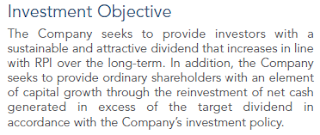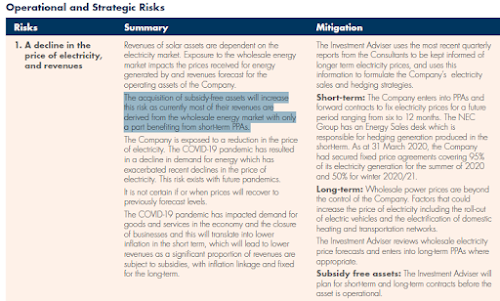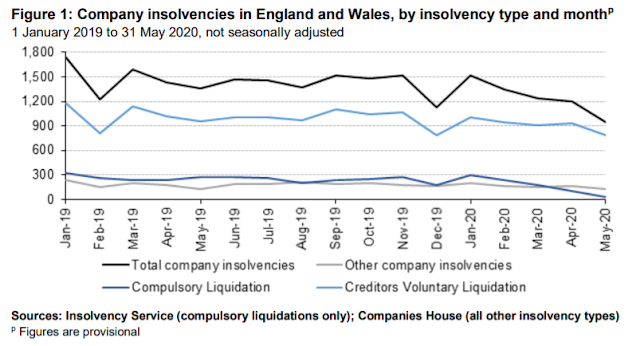Investing is
often talked about in terms of risk and reward, and as an attempt to balance
these two elements. Currently everything feels risky, governments
have been putting their economies into hibernation, central banks have turned
the money printers up to 11, all to help combat a virus to which we have no
medical solutions.
So given the
rather frisky nature of the markets of late I decided to look into how investors
try to measure risk.
As we’ll see
below to a large extent risk is often framed in terms of volatility. To some
extent I think this is reasonable. If an investment moved 50% up and down
randomly from an average price each day, it would be quite difficult to know
when might be a good time to buy or sell. Another investment that only moved 5%
would provide some consistency in pricing that might make owning it more
palatable.
Perhaps more
problematic with using volatility as a measure of risk is that in one direction
volatility is surely desirable – a valuation moving rapidly upwards is
generally regarded as a good thing. The same degree of volatility going the
other way isn’t usually welcome.
I'll look at 3 risk measures:
Beta
Sharpe ratio
Sortino ratio
I’ve set up a
googlesheet here to download and play with if you’re so inclined. It shows the measures above, with all the components broken out. It also has a simple scatterplot with regression line, correlation and r², in case these also float your boat.
Beta
Beta is a
notion that essentially compares the volatility of an investment against a
benchmark (the “market”). The benchmark is given a beta of 1, a beta above 1
indicates that the investment is more volatile than the benchmark, and a beta
less than 1 that it is less volatile than the benchmark.
You’ll find
it on sites like Yahoo finance – looking at a couple of examples on there, as
of mid-May 2020 Diageo has a beta of 0.33 and Lloyds has a beta of 1.1. Booze
is less volatile than banking apparently. However, Yahoo don’t state how they
have calculated the figure, so a little pinch of salt is required, but it is probably
correct to think that a company selling booze will have more stable and
consistent returns than a bank which will be tightly aligned to macro-economic
conditions.
Beta doesn’t state an absolute degree of volatility but relative to a
benchmark. It is a function that for any given input tells us what to expect as an output. In the cases above, if the numbers are to be believed, for every 1%
of change in the market, Diageo typically has a change of 0.33%, and Lloyds has
a 1.1% change.
Lets take a
simple example to understand the principle better, there are plenty of rabbit
holes online to disappear into if complexity is what you’re after.
Beta tells
us roughly what % change to expect in an asset’s price given a 1% change in the
market. Let’s set up a simple pretend business “WidgetX” and see how it
performs in good and bad conditions, and how the market also performs:
|
Good times
|
Bad times
|
WidgetX
|
30%
|
-20%
|
Market
|
20%
|
-10%
|
What we can
see here is that the price of an investment in WidgetX tends to be up by around 30% when market
conditions are good, but down by 20% when conditions are bad. Whereas the
market tends to be up by 20% and down by 10% during these conditions.
If we take
the range of scores from WidgetX and the market we get:
WidgetX
range = 50
Market range = 30
50/30 = 1.67
So if the
market changes by 1%, WidgetX tends to change by 1.67%, which tells us the
company is rather sensitive to changes in the underlying market. A bit like
Lloyds above which typically moves more than the market, Diageo, on the other
hand is insensitive to market conditions, they keep selling booze no matter
what’s going on.
To come back
to the point above about volatility and direction, this sensitivity will result
in a greater movement up and down, so we might expect Lloyds to outperform the
market in good years, and to underperform in bad. Diageo, would likely
underperform the market in good years and outperform in bad.
Beta is calculated as follows:
Beta =
covariance of investment & market / variance of the market
The
covariance of both investment & market measures how these two move relative
to each other. A positive number indicates that they tend to move in the same direction together. A negative number indicates that they tend to move in opposite directions.
The market
variance is simply the amount of variability in the returns from the market from an average - the mean return.
This is all very well, but as discussed more below, not all volatility is created equal.
Sharpe ratio
The Sharpe ratio
is next on the list and is described as a way to understand an investment’s “risk-adjusted
returns”. In other words the amount of return per unit of risk. As with beta
above, the notion of risk is based on volatility – in this case the standard
deviation of the investment’s returns. (To save a google for those rusty with stats,
standard deviation is a measure of the variability of data, which is established by measuring the distance of each
data point from the mean of all of the data)
The “return”
in the Sharpe ratio is the return of the investment after taking away the return
that a “risk-free” alternative would have generated. What is left after the “risk-free
rate” is subtracted is called the “excess return”. The "risk-free rate" is often represented by US Treasuries
(debt backed by the US Govt). Given that at the time of writing,
mid-May 2020, the 2, 5 and 10yr US Treasuries yield less than 1%, they may not be
the best “risk free rate”, the 30 yr only has a yield of 1.42%...
After
finding our excess return we then divide this by our volatility – the standard
deviation of the investment’s returns. This gives us a measure of return for
each unit of volatility.
A quick
example, imagine our WidgetX business above generates a return of 25% and we
have a risk free rate of 5% then the excess return is 25% - 5% = 20%. If the
standard deviation of the WidgetX returns was 15, we would then divide the excess
return by this, 20/15 = 1.33. So our Sharpe ratio would be 1.33.
What does a Sharpe
ratio of 1.33 mean? On it’s own, not a lot, but using it to compare different
investments might help – let’s see how the iThing company measures up to
WidgetX
|
Return
|
Risk free rate
|
Standard deviation
|
Sharpe ratio
|
WidgetX
|
25%
|
5%
|
15
|
1.33
|
iThing
|
25%
|
5%
|
10
|
2
|
Both
companies generate the same return, but have quite different Sharpe ratios,
telling us that for each unit of risk, WidgetX gives us 1.33 return, whereas iThing
gives us a return of 2. Since the return on both investments
is the same (25%) it is the denominator in our equation that changes, that the
risk, or volatility of iThing is less than WidgetX.
The Sharpe ratio
is calculated as:
Sharpe ratio = (Investment
return – risk free rate) / standard deviation of investment returns
By using the
Sharpe ratio we could try to build a portfolio that generated the highest
return for the least amount of volatility.
It does,
however, have the same fundamental issue as beta, it assumes that all
volatility is the same. A 10% change in the price of an investment has the same
amount of volatility whether it is up or down – it’s impact on the likelihood of me achieving my financial goals is not the same however. I want to be exposed to
the risk of my investments going up. Risk should have a component that accounts
for the detrimental impact of something that makes goals more difficult to achieve.
Our final ratio does just that.
Sortino ratio
The Sortino
ratio is a modification of the Sharpe ratio. It is calculated in a similar way
but rather than using the deviation all all price movements to represent risk, it focuses on the
element of volatility most of us find uncomfortable – prices falling.
Before digging
into the Sortino ratio lets first revisit the statistical notion of standard
deviation as it is this that is modified in the shift from Sharpe to Sortino.
“In statistics, the standard deviation is a measure of the amount of variation or dispersion of a set of values.A low
standard deviation indicates that the values tend to be close to the mean (also called the expected value) of the set, while a
high standard deviation indicates that the values are spread out over a wider
range.”
It is calculated by first establishing the mean of the set
of values, and then measuring the distance of each value from the mean. A
little more numerical jiggery-pokery gets you to the standard deviation. In most uses
this is perfectly reasonable, but as mentioned a few times above, as investors,
the direction of the deviation matters. This deviation is regarded as volatility
in investing, which is equated, rightly or wrongly with risk. What we really
need to do is extract the risky part of the volatility – i.e. an investment
losing value.
Downside deviation is what we are looking for. This focusses
specifically on downward price movements and uses the volatility of those negative
movements – the standard deviation of the losses.
The Sortino ratio calculation is below:
Sortino ratio = (Investment
return – risk free rate) / standard deviation of negative investment
returns
I’ve highlighted the word “negative” above, as it is the
key difference between the Sortino and the Sharpe ratio.
Let’s take our two companies again and apply the Sortino ratio:
|
Return
|
Risk free rate
|
Standard deviation of negative returns
|
Sortino ratio
|
WidgetX
|
25%
|
5%
|
5
|
4
|
iThing
|
25%
|
5%
|
10
|
2
|
In this case both companies have a return of 25%, from which
we subtract the risk free rate of 5%, to leave both with a return of 20%.
WidgetX has a lower volatility of downside movements, it’s standard deviation
of those movements are 5, whereas iThing has a much more volatile price, with a
standard deviation of 10. If we plug these numbers into the denominator of our
sortino ratio, we get a score of 4 for WidgetX and 2 for iThing. This indicates
that we although we got the same return for both, we had to suffer twice the
amount of downside volatility for iThing than WidgetX. As a risk adjusted
return, to me this captures much more of the notion of risk, i.e. risk of
losing money, than the Sharpe ratio (which includes the risk of making money).
The Sharpe ratio penalises an investment for price appreciation
which is included in it’s definition of risk. Whereas the Sortino ratio isolates
risk from return by focusing only on downwards price movements – the negative
volatility that investors would prefer to avoid.
So as a risk averse investor I should
seek out potential investments with a higher Sortino ratio because it means
that the investment has earned more return per unit of risk that it takes on.
The Sortino ratio seems closely aligned to the sensible idea of not losing money, which I discuss
here.
To save you scrolling back up, the
link to the googlesheet with all the above calculations is here.















